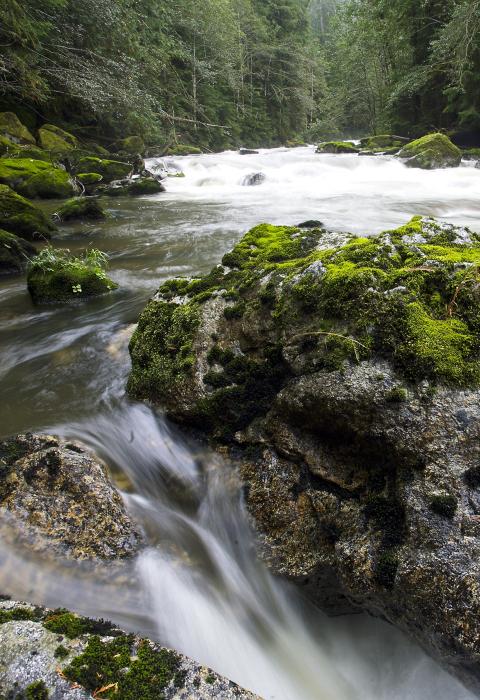Skagit River
Washington
The Skagit River, in northwest Washington, is the largest and most biologically important river draining to Puget Sound. The Skagit River System includes a portion of the Skagit River from Bacon Creek downstream to just east of the town of Sedro Woolley, which is classified as recreational. Three tributaries—the Sauk, Suiattle, and Cascade Rivers—are classified as scenic. The system is 158.5 miles long and includes over 38,000 acres. Approximately 50% of the river system is in private ownership, primarily in the Skagit and lower Sauk. The upper Suiattle, upper Cascade, and upper Sauk are on the Mt. Baker-Snoqualmie National Forest.
Whitewater rafting is popular on the Sauk and Suiattle Rivers. Commercial guides require permits from the U.S. Forest Service. Private boaters do not require permits. Winter eagle viewing on the upper Skagit draws thousands of visitors from November to February. Fishing for steelhead, coho, and Chinook is popular on the Skagit and lower Sauk rivers.
Designated Reach
November 10, 1978. The segment from the pipeline crossing at Sedro-Wooley upstream to and including the mouth of Bacon Creek. The Cascade River from its mouth to the junction of its North and South Forks; the South Fork to the boundary of the Glacier Peak Wilderness Area. The Suiattle River from its mouth to the boundary of the Glacier Peak Wilderness Area at Milk Creek. The Sauk River from its mouth to its junction with Elliott Creek. The North Fork of the Sauk River from its junction with the South Fork of the Sauk to the boundary of the Glacier Peak Wilderness Area. The North Fork of the Cascade River from its confluence with the South Fork to the boundary of North Cascades National Park.
Outstandingly Remarkable Values
Fish
Skagit river is host to a number of fish species including chinook and chum salmon and steelhead.
Scenery
The scenery around the Skagit River includes views of surrounding mountain peaks, volcanic peaks, glaciers, and deep forested valleys.
Wildlife
A vigorous wildlife community inhabits the Skagit WSR system. Deer, bear, elk, waterfowl, fur-bearers, and rodents all abound. The Skagit River basin is home to some rarely seen species—trumpeter swan, whistling swan, Ross's and goose, and bald eagle, especially in winter.
Bald eagles gather in significant numbers along the entire Skagit during the winter to feed on the carcasses of spawned out chum salmon. This congregation of eagles is one of the largest wintering populations of bald eagles in the lower 48 states. The bald eagle is most often seen along the middle floodplain in stretches of undeveloped timber land. Both adults and juveniles are frequently seen perched in trees along the river bank. A small number of these magnificent birds are permanent residents of the basin. Many additional eagles visit the basin during late fall and early winter following the height of the annual anadromous fish migration. Hundreds have been counted during this period. A large eagle sanctuary has been established by the Nature Conservancy on the south bank of the Skagit, upstream from Rockport.

